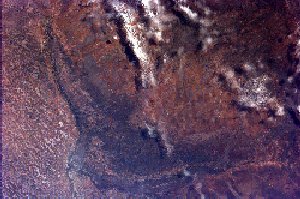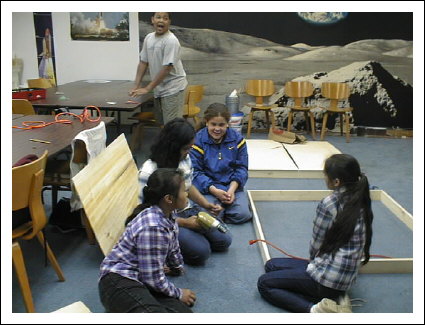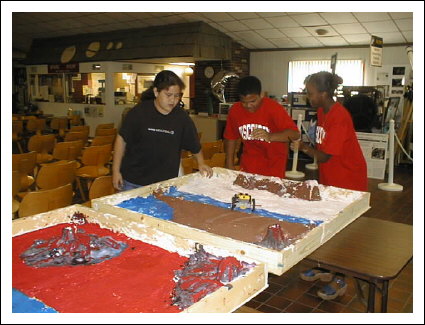Monthly News Summary – July 2000
Images from Space
by Terri Gregory, SSEC Public Information Specialist
July 2000
This column covers news received in June.
…from Earth orbit
SSEC’s EarthKam program, for Earth Knowledge Acquired by Middle-Schoolers, was one of thirteen university outreach programs honored by UW–Madison Chancellor David Ward in a reception at the chancellor’s residence on June 14. It was the fourth annual University & Community Partnerships event. The press were invited and the Capital Times (June 14) and Madison Times (June 23-29) covered the awards.
Rosalyn Pertzborn and Sanjay Limaye of SSEC’s Office of Space Science Education worked with James Kotoski to bring EarthKam to Spring Harbor and Hamilton Middle School students. In EarthKam, students in participating schools take pictures of the earth by requesting time on a digital camera in the Space Shuttle. Students in the program deal with all the earthbound hazards of a space mission, including glitches in the data. According to Rosalyn, “On the first day of the mission, seventh grade students at Spring Harbor and Velma Hamilton Middle Schools observed that the orbital tracks were displaced by a few degrees because the shuttle’s altitude was not as high as originally projected. Although the new flight tracks were not posted on the Web site for the EarthKAM schools until several days later, Mr. Kotoski’s students adjusted all of their image requests accordingly and were the only school in the country to obtain images during the first day of the mission!”
The pictures students collected are posted on the Web and are used in geography, sociology and other classes. The Madison Times’ Heidi Pascual interviewed Sanjay and Rose, who explained that the program was started by Sally Ride, the first American woman astronaut.
 |
This image was taken during STS-89 in January 2000. It shows a point in northern Namibia at 19°S 13°E. |
For more information, follow these links.
…from geostationary orbit
Scientists in the Cooperative Institute for Meteorological Satellite Studies are assessing data from the newest GOES satellite. GOES-11 was launched on May 3 as a backup for current weather satellites in geostationary orbit, GOES-8 and GOES-10. GOES-8 was launched in April 1994. Normal life expectancy for these satellites is five years. GOES 8 and 10 cover the earth’s western hemisphere. This third satellite is positioned between them, over the United States, ready to be brought into service when either current operational satellite fails.
It’s normal to test a new satellite to make sure it functions properly, but GOES-11 gives scientists an unusual opportunity to test at length to see what applications it is best suited for. CIMSS researchers have begun to show comparisons between current and new satellite capabilities at a Science Test Web site. One page compares sounder channels of GOES-8 and GOES-11, showing excellent agreement, even during final engineering checkout. CIMSS scientists so far think they see less striping and noise in images and data from the GOES-11 sounder, the instrument that provides information for satellite products for use in weather forecasting and research. Researcher Tony Schreiner said, “there is certainly less noise in the infrared Sounder data, especially the short wave bands. This ‘cleaner’ data translates into ‘cleaner’ derived products.”
The NOAA science test began on June 30th.
…from Mars
Scientists have assumed for some time that water must have flowed on Mars, but till recently it seemed that happened long ago. Recent high-resolution images taken by the Mars Global Surveyor Mars Orbiter Camera “suggest that liquid water has seeped onto the surface in the geologically recent past,” according to scientists who work with data from the camera. Gullies shown in the new imagery are “too small to have been detected by the cameras of the Mariner and Viking spacecraft,” earlier Mars exploring craft. The issue has received so much attention that Science magazine posted articles on its Web site scheduled for print on June 30.
SSEC planetary scientist Sanjay Limaye is well versed in all things Martian. Sanjay was interviewed on Madison’s public television Weekend program, Friday, June 23, explaining the Mars Surveyor images. When interviewer Jerry Hoffman asked about the water, Sanjay replied, “Sure, I’d drink Mars water.” The Milwaukee Journal Sentinel covered the story on June 23, and Sanjay said, “There could be areas of Mars that are teeming with bacterial life.” Sanjay also appeared on WORT-FM’s science show on Thursday, June 29 and spoke to a Space Place audience on Tuesday, June 27.
Project News
For More Information
In The Earth Observer for March/April, EOS Senior Project Scientist Michael King named CIRRUS, the Cloud Infrared Radiometer for University Earth System Science, one of four winning proposals for the University Earth System Science program. These four concepts will be developed for spaceflight and, in about six months, two projects (and a backup) will be selected for a mission.
The Wisconsin Radio Network produced a piece on CIRRUS. The WRN syndicates its stories so this piece could appear all over the state.
CNN.com’s Environmental News Network posted a slightly edited version of the UW–Madison news release on June 13. It also links to SSEC’s MODIS Remote Sensing of Cirrus Clouds Working Group’s Web page and to Steve Ackerman’s home page, under Related Sites. Steve is Principal Investigator of CIRRUS.
Icebergs
ENN’s Lucy Chubb took a scientific standpoint and provided useful detail on the causes of iceberg calving in a story posted in late March.
NSF director Rita Colwell used an AMRC satellite image of iceberg B-15, broken in half, in a talk at the University of Colorado campus on June 20. Entitled “Polar Connections,” the talk focused on the wide-ranging activities of the NSF Polar Research Program and was part of NSF 50th and UCAR 40th anniversary activities in Boulder.
The New Zealand Antarctic Society’s bulletin, “Antarctic;” and the book, Unity and Diversity of Life, will include a B-15 image. The June 20 “Eco Minute” on WMMM 105.5 FM radio in Madison featured iceberg B-15. The Providence Rhode IslandSunday Journal covered the iceberg story.
Rain
Soggy Dane County residents endured a record-breaking 30 days ending June 15. SSEC Researcher Scott Lindstrom and AOS Professor John Young used records from the State Climatologist’s office to show that that period is the rainiest in the past 100 years. UW–Madison’s Communications Office posted the story on its Web site. In an article on high lake levels on June 17, the Wisconsin State Journal attributed rain statistics to anonymous “UW researchers.” Scott was noted as the statistics’ source in a Menominee Falls newspaper. Scott’s rain statistics also were published in the daily email announcements at the Madison offices of Foley and Lardner on June 14, 16 and 20.
On the Net
For More Information
UW-Madison’s communications office updated its “In the News” column June 1 with Space.com’s multipart article on hurricanes, featuring Chris Velden in a section on modeling and data analysis. The tropical cyclones group’s research is also featured in the June 30 premier issue of a UW–Madison newsmakers tip sheet for media.
The Wisconsin Milk Board’s Web site links to SSEC weather imagery on its front page and gives SSEC its own section in Weather Resources. SSEC links include Current Wisconsin Weather and the Upper Midwest Regional Earth Science Applications Center. SSEC is prominently credited.
SSEC’s home page is listed in the space-oriented Web site, Universe Today. Click on Space Links, and then on University Departments.
Broadcast
Weather Guys Steve Ackerman and Jonathan Martin returned to Wisconsin Public Radio on Monday, June 26. On Jim Packard’s call-in show they received good questions about global warming, including the carbon cycle, computer modeling of the atmosphere and the ocean, and storm classifications, interspersed with quips and gentle verbal sparring. This has been the warmest spring on record, they said. But not in Madison, said a caller.
Chris Velden attended the National Press Club’s forum on hurricane forecasting and preparedness issues. Chris was an observer-participant at the forum, sponsored by the American Meteorological Society and the Weather Channel. The event took place in Washington, DC on June 6–7 and was carried by CSPAN.
The Australian Broadcasting Corporation will use Antarctic composite images from the Antarctic Meteorological Research Center in a program called “South of No North.”
In Print
For More Information
England’s Remote Imaging Group will use the first GOES-11 visible image in the June issue of their journal. The group’s members come from “education and amateur [remote sensing] communities.
The Campus Open House events list includes “interactive space science and engineering activities,” as noted in On Wisconsin, the UW alumni magazine. A news release by chancellor’s assistant Noel Radomski called us “Stars of Heaven and Earth.” The open house is scheduled for the weekend of August 18–20, with events in the Atmospheric, Oceanic and Space Science Building to take place on Saturday, the 19th, from about noon to five.
SSEC’s Web site is listed in Applications and Investigations in Earth Science, a lab manual by Tarbuck, Lutgens, and Pinzke. The manual is used in earth science high school classes in New York City.
In its July issue, Florida Trend magazine will use an image of Hurricane Floyd provided by the CIMSS Tropical Cyclones group.
SSEC is listed in the International Satellite Directory for 2000. The directory is published in two volumes; the 2000 edition includes a forward by Sir Arthur Clarke.
Watch Wisconsin Trails magazine for the university advertisement promoting weather research. This is the same “rubber boots” ad that appeared in the May/June issue of Midwest Express magazine. The ad may also appear in Milwaukeemagazine.
Outreach and Honors
For More Information
For three weeks in June, twelve middle school students used UW–Madison’s Space Place to explore the solar system. In this simulated space mission, students from four Madison middle schools designed a planet, built and launched a rocket, created a habitat, and built and programmed a roving planetary vehicle.
 |
Middle school students in PEOPLE space workshop gleefully begin their world. |
Facilitators in this daring effort were Sanjay Limaye and Rosalyn Pertzborn (SSEC’s Office of Space Science Education), and Jim Lattis and Kay Kriewald (Department of Astronomy’s Space Astronomy Laboratory). Along the way, the young explorers learned quite a bit of science—how to use a telescope, what sunspots are and how they move, crater formation, and planetary characteristics. The workshop was one of several ambitious offerings in UW–Madison’s summer Pre-college Enrichment Opportunity Program for Learning Excellence, or PEOPLE. Another workshop created its own newspaper, da PEOPLE flava, and covered the space exploration workshop.
 |
Nearly three weeks later, members of two PEOPLE teams show off their worlds. |
Wisconsin Week Wire for June 14 mentioned under Milestones the Banner Miller award received by Tropical Cyclones group researchers. Researchers Chris Velden, Tim Olander and Steve Wanzong (now with Technical Computing) received the award (with a NOAA colleague) for significant research on hurricanes. Scott Sandgathe, project manager with the Office of Naval Research, congratulated the team on the award, and thanked them for their work for ONR. “Dollar for dollar,” he said, “I can’t think of a better investment we’ve made recently.”
